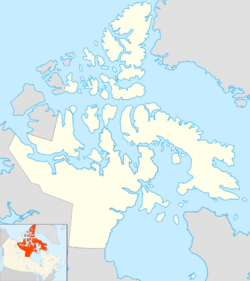Coats Island facts for kids
|
Native name:
Akpatordjuark
|
|
|---|---|

Coats Island, Nunavut
|
|
 |
|
| Geography | |
| Location | Hudson Bay |
| Coordinates | 62°35′N 082°45′W / 62.583°N 82.750°W |
| Area | 5,498 km2 (2,123 sq mi) |
| Highest point | 185 m (607 ft) |
| Administration | |
| Nunavut | Nunavut |
| Region | Kivalliq |
| Demographics | |
| Population | Uninhabited |
Coats Island, also called Akpatordjuark in Inuktitut, is an island located at the northern end of Hudson Bay. It is part of the Kivalliq Region in Nunavut, Canada. This large island covers about 5,498 square kilometers (2,123 square miles). This makes it the 107th largest island in the world. It is also the 24th largest island in Canada.
Some parts of the island are federal land, while other parts are owned by Inuit people. The last people who lived there permanently left in the 1970s. Because no one lives there now, Coats Island is the largest uninhabited island in the northern hemisphere that is south of the Arctic Circle. It was once the home of the Sadlermiut people. Many believe they were the last group of the ancient Dorset culture.
| Top - 0-9 A B C D E F G H I J K L M N O P Q R S T U V W X Y Z |
Geography of Coats Island
Coats Island is about 130 kilometers (81 miles) long. The highest point on the island is 185 meters (607 feet) above sea level. This high area is found along the rocky northern edge. It is located between two places called Cape Pembroke and Cape Prefontaine.
The rocks in this northern part are very old. They are called Precambrian metamorphic rocks. Less than 5% of the island is more than 100 meters (328 feet) above sea level. The southern half of the island is mostly low and wet. This area is made up of younger rocks. These include limestone and sandstone.
Animals and Wildlife
Since 1920, Coats Island has been a special place for reindeer or caribou. Caribou had disappeared from nearby Southampton Island. So, the caribou from Coats Island were used to bring them back to Southampton Island.
The island is also famous for its large number of thick-billed murre birds. There are two big groups of these birds. Each group has about 30,000 birds. They live on the cliffs at the rocky northern end of the island.
You can also find many walrus on Coats Island. They gather at special spots called haulouts. These are at the bottom of cliffs or on small islands near the northern end. Inuit people from Coral Harbour, which is on Southampton Island, often visit these spots. They come to hunt walrus for food.
Cape Pembroke, on Coats Island, is known as an Important Bird Area. This means it is a very important place for many kinds of birds.
History of Coats Island
The first time Coats Island was seen by Europeans was in 1612. This was by an explorer named Thomas Button. He explored the island more in the next year. The island got its name from William Coats. He was a sea captain who worked for the Hudson's Bay Company. Captain Coats visited the area many times between 1727 and 1751.
In 1824, a ship called HMS Griper visited Coats Island. Its captain was George Francis Lyon. They stopped near Cape Pembroke on the island. The sailors on the ship met a group of "Eskimos." These people spoke a different language. They were known as the Sadlermiut. Over time, the Sadlermiut continued to meet people from Western countries. However, like many Indigenous groups in North America, the Sadlermiut were not used to Western diseases.
American whalers started visiting the area in the 1860s. They confirmed that the land was indeed an island. By 1896, there were only about 70 Sadlermiut people left. Then, in the fall of 1902, a British ship called the Active stopped at Southampton Island. It is believed that some Sadlermiut caught a sickness from a sick sailor on this ship. This sickness, possibly a type of flu or fever, then spread to everyone in their community. By the winter of 1902-1903, all the Sadlermiut people had passed away because of this illness.
The Hudson's Bay Company had a trading post on Coats Island. It was open from August 1920 to August 1924. During this time, some Inuit families lived on the island. Some of them had traveled from Baffin Island by boat. In 1921, Captain George Cleveland found an overturned fishing boat on Coats Island. Underneath it were two skeletons. People thought these might be the remains of Captain Arthur Gibbons and one of his officers. They were survivors from a shipwreck of an American whaling ship called the A. T. Gifford. The Canadian Government then started an investigation into this discovery.
See also
 In Spanish: Isla Coats para niños
In Spanish: Isla Coats para niños



